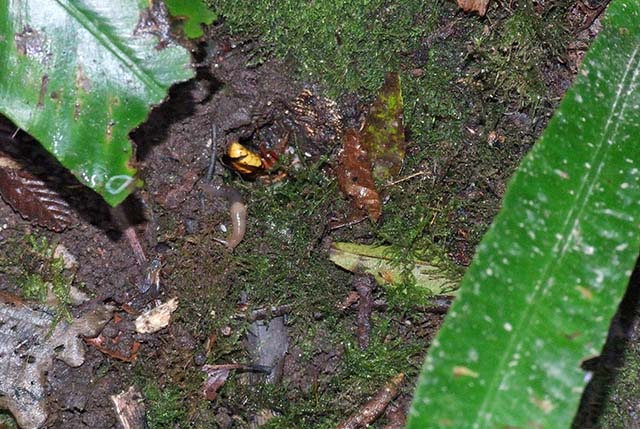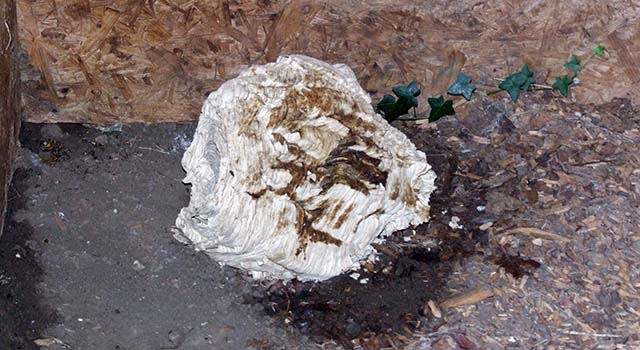This one is just a “nature diary” piece, so don’t expect any geopolitical insights – or even conclusions about nature, come to that. Most years we find a wasp-nest somewhere on our two and a half acre spread, but this year it was hornets.
The wasps are seldom a real nuisance, in fact sometimes providing interesting observations, as per here, though last year’s nest, in our loft, got a little interesting when we had a corner of our lounge ceiling collapse from an undetected roof leak. As the wasps got hungry and dozy when the weather got cold, a good number of them found the way through into our living room, and evictions were a regular part of our life for a few weeks. But no real harm was done.
I’ve even accidentally mowed over nests in our meadow, for common wasps often do nest underground. Fortunately on both occasions I avoided provoking a mass attack on myself or the mower.
Hornets are another matter. I’ve spotted early hornet nests in previous years, usually in a stable or outhouse. Because of their situation I’ve “discouraged” them with insecticides, partly because these are working spaces, and partly because of our small grandchildren’s”s frequent visits. But I’ve long-since stopped associating them automatically with the limerick of my childhood:
There was a young man of Dundee,
Who was terribly stung by a wasp.
When asked if it hurt, he said,
“No, not a bit.
It must have been a dirty great hornet.”
This year I somehow missed the nest on the ceiling of an unused field-shelter before it was too big to deal with safely, so I’ve left it alone.
Hornets turn out to be better neighbours than wasps. Being country folk, they are to be seen flying in and out away from the house in the direction of the woods. So you don’t find them trying to steal your barbecue meal or drowning themselves in your cider. And these, being European hornets (Vespa crabro) rather than the infamous Asian immigrants, are known to be pretty placid, unless you interfere with their nest, which practice I have studiously avoided.
But two unexpected phenomena have happened amongst my hornet neighbours, which may or may not be related. The first was my noticing a hornet outpost, whilst walking my dog in the nearby unmetalled lane, in a place where hornets are not supposed to be, according to my online sources. I noticed a couple of the creatures buzzing around the base of an oak tree, which is on the opposite side of the lane to the field-shelter, and about sixty feet distant from it. They seemed to be emerging from what looked like an old vole-hole, maybe a couple of inches across, and were mildly defensive if Charlie, or me, got too close.
Over the weeks, one or two hornets could usually be seen there, revising my idea that they’d found a beetle or something to predate. And in fact, I began to notice the odd twig or leaf “coincidentally” lying across the entrance. I was unsure if nature was setting out to inconvenience my hornet chums, or whether they were actually gathering materials to close off an entrance to a nest.
The whole thing is odd, because according to the sources, hornets always nest high up, and never underground (unlike wasps), and this site is a small hole at the base of a living oak, not a cavity high in an old hollow tree. But this week it is very clear that some deliberate activity is going on, as this photo shows.
You can see what seems to be a sentinal hornet, sting at the ready, which is present most times I pass. And there is a very neat mossy closure (not the usual hornet paper, notice) of a hole whose original outline was roughly the circle outlines by leaves and slugs. Like the slug a lazy fly (to the left) also appears to be unfazed by a dangerous predator close by – perhaps they are tourists, like those admiring the guards at Buckingham Palace..
It was some weeks after I noticed this apparently unusual hornet outpost of my nest (or maybe it’s the advance position of an invading colony nearby, who knows?) that I dared to poke my head into the field shelter to see how big the first nest had become. It was indeed a monster, about the size of a soccer ball and well able to hold the several hundred workers the sources talk about. But it had also, it turned out, fallen off the roof and on to the ground – a part of the hornet life-cycle not mentioned in Wikipedia! Here’s its status this week. You can tell the size from the ivy leaves:
Further observation showed that, at least until the recent colder weather, the hornets were still soldiering on and using the nest, which has not been predated by badgers as one of our wasp nests was in the past. Plucky little blighters, they are, though of course they will all, routinely, die when the winter sets in and the new queens have gone into winter shelter somewhere.
So I’m left wondering whether hornets routinely maintain outpost colonies in vole-holes, which the literature seems not to mention; or whether the queen abandoned the nest when it fell, accompanied by a few retainers, and is eking out her existence in exiled poverty like Bonny Prince Charlie in Spain; or whether the tree-root lot are a rival colony closer to the metropolis than is good for them, or even (letting my imagination run wild) the Adullam’s cave of some illegitimate queen that escaped the policing of workers (the usual situation) and is plotting a rebellion.
I have no answers to any of these speculations, and am certainly open the insights of any vespologists happening to read this. But I record this to remind myself, and you, that the nature on our doorsteps still has plenty of mysteries to intrigue us.
And perhaps in order to gain a few new converts from the rampant antihornetism of our times.

Hi chaps! Anyone fancy cricket?


